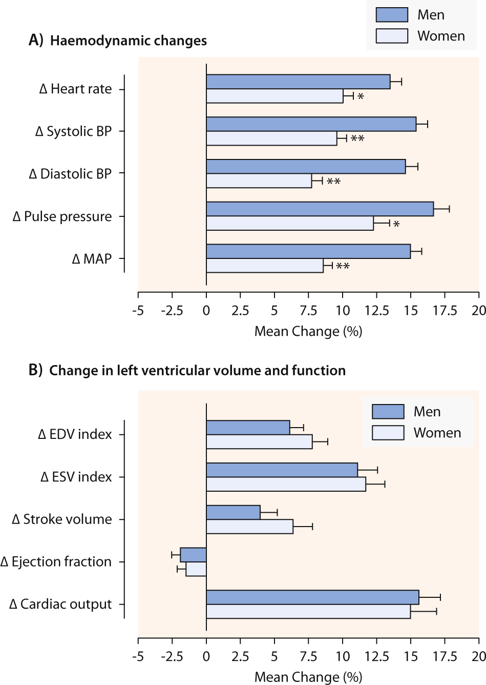当前位置:
X-MOL 学术
›
J. Hum. Hypertens.
›
论文详情
Our official English website, www.x-mol.net, welcomes your feedback! (Note: you will need to create a separate account there.)
Impact of age, sex and heart rate variability on the acute cardiovascular response to isometric handgrip exercise.
Journal of Human Hypertension ( IF 2.7 ) Pub Date : 2020-02-10 , DOI: 10.1038/s41371-020-0311-y Nicholas Cauwenberghs 1 , Véronique Cornelissen 2 , Jeffrey W Christle 3 , Kristofer Hedman 4 , Jonathan Myers 3, 5 , Francois Haddad 6 , Tatiana Kuznetsova 1
Journal of Human Hypertension ( IF 2.7 ) Pub Date : 2020-02-10 , DOI: 10.1038/s41371-020-0311-y Nicholas Cauwenberghs 1 , Véronique Cornelissen 2 , Jeffrey W Christle 3 , Kristofer Hedman 4 , Jonathan Myers 3, 5 , Francois Haddad 6 , Tatiana Kuznetsova 1
Affiliation

|
Isometric handgrip exercise (IHG) triggers acute increases in cardiac output to meet the metabolic demands of the active skeletal muscle. An abnormal cardiovascular response to IHG might reflect early stages of cardiovascular disease. In a large community-based cohort, we comprehensively assessed the clinical correlates of acute cardiovascular changes during IHG. In total, 333 randomly recruited subjects (mean age, 53 ± 13 years, 45% women) underwent simultaneous echocardiography and finger applanation tonometry at rest and during 3 min of IHG at 40% maximal handgrip force. We calculated time-domain measures of short-term heart rate variability (HRV) from finger pulse intervals. We assessed the adjusted associations of changes in blood pressure (BP) and echocardiographic indexes with clinical characteristics and HRV measures. During IHG, men presented a stronger absolute increase in heart rate, diastolic BP, left ventricular (LV) volumes and cardiac output than women, even after adjustment for covariables. In adjusted continuous and categorical analyses, age correlated positively with the increase in systolic BP and pulse pressure, but negatively with the increase in LV stroke volume and cardiac output during exercise. After full adjustment, a greater increase in systolic and diastolic BP during exercise was associated with lower absolute real variability (P ≤ 0.026) and root mean square of successive differences (P ≤ 0.032) in pulse intervals at rest. In a general population sample, women presented a weaker cardiovascular response to IHG than men. Older age was associated with greater rise in BP pulsatility and diminished cardiac reserve. Low HRV at rest predicted a higher BP increase during isometric exercise.
中文翻译:

年龄、性别和心率变异性对等长握力运动的急性心血管反应的影响。
等距握力运动 (IHG) 会触发心输出量的急剧增加,以满足活跃骨骼肌的代谢需求。对 IHG 的异常心血管反应可能反映了心血管疾病的早期阶段。在一个基于社区的大型队列中,我们全面评估了 IHG 期间急性心血管变化的临床相关性。总共有 333 名随机招募的受试者(平均年龄,53 ± 13 岁,45% 女性)在休息时和 IHG 3 分钟期间以 40% 的最大握力同时接受超声心动图和手指压平眼压测量。我们从手指脉冲间隔计算了短期心率变异性 (HRV) 的时域测量值。我们评估了血压 (BP) 和超声心动图指标的变化与临床特征和 HRV 测量的调整关联。在洲际酒店集团期间,即使在调整了协变量后,男性的心率、舒张压、左心室 (LV) 容积和心输出量的绝对增加也比女性更强。在调整后的连续和分类分析中,年龄与收缩压和脉压的增加呈正相关,但与运动期间 LV 每搏输出量和心输出量的增加呈负相关。完全调整后,运动期间收缩压和舒张压的更大增加与较低的绝对真实变异性 (P ≤ 0.026) 和静息时脉搏间隔连续差异的均方根 (P ≤ 0.032) 相关。在一般人群样本中,女性对 IHG 的心血管反应比男性弱。年龄较大与血压搏动的升高和心脏储备减少有关。
更新日期:2020-02-10
中文翻译:

年龄、性别和心率变异性对等长握力运动的急性心血管反应的影响。
等距握力运动 (IHG) 会触发心输出量的急剧增加,以满足活跃骨骼肌的代谢需求。对 IHG 的异常心血管反应可能反映了心血管疾病的早期阶段。在一个基于社区的大型队列中,我们全面评估了 IHG 期间急性心血管变化的临床相关性。总共有 333 名随机招募的受试者(平均年龄,53 ± 13 岁,45% 女性)在休息时和 IHG 3 分钟期间以 40% 的最大握力同时接受超声心动图和手指压平眼压测量。我们从手指脉冲间隔计算了短期心率变异性 (HRV) 的时域测量值。我们评估了血压 (BP) 和超声心动图指标的变化与临床特征和 HRV 测量的调整关联。在洲际酒店集团期间,即使在调整了协变量后,男性的心率、舒张压、左心室 (LV) 容积和心输出量的绝对增加也比女性更强。在调整后的连续和分类分析中,年龄与收缩压和脉压的增加呈正相关,但与运动期间 LV 每搏输出量和心输出量的增加呈负相关。完全调整后,运动期间收缩压和舒张压的更大增加与较低的绝对真实变异性 (P ≤ 0.026) 和静息时脉搏间隔连续差异的均方根 (P ≤ 0.032) 相关。在一般人群样本中,女性对 IHG 的心血管反应比男性弱。年龄较大与血压搏动的升高和心脏储备减少有关。


























 京公网安备 11010802027423号
京公网安备 11010802027423号